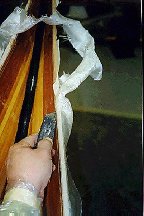
 |
||||
| INDEX | next
|
 |
This
second type, is done on the deck. Note that the deck was built from the
sheerline of the already glassed hull. The only way to prevent the epoxy
from fusing the bead and cove sheer together was to tape it. The black drip skirt guides epoxy runs and water from wet sanding away from the hull. See the top photo. At last, scoring the glass just above the masking tape allows you to peel everything away cleanly. The outside of the deck was wet sanded and is also ready for varnish. |
 |
The
last type of fiberglass trimming will be done on the inside of both hull
and deck. Be careful not to rip off the fragile coves of the sheer strip
when you peel off the protective masking tape. As I mentioned before, a small band of the sheer strip will stay raw, but that will be taken care of when the shells are taped and bonded together later. Note the strip of carbon cloth reinforcing the rounded fillet in the stems. Normal glass tape is fine also. Speaking of fillets, any sharp cornered voids such as the inside stems must be filled prior to glassing with lightweight epoxy slurry, otherwise the cloth will not adhere. |
 |
'Smiling' Cape Ann Expedition ready to leave the mold. The shallow deck is always easier to remove. |
| INDEX |
| Home | Kayak Designs | Kayak Shop | Materials | Kayak Gallery | About us |
| Building Manual | Plans | Sandwich Core | Wood Kayak | Order | |
| Epoxy Test | Abrasion Cloth | Rudder | Resources | Choosing Kayak | Guestbook |
If you notice any problems with the site (i.e. error links, missing images) please, let me know. Thanks
Mail:
Vaclav Stejskal
58 Wood Ln.
Acton, MA 01720
USA
Tel: 781-481-9261
© 1999
- 2024 Copyright Vaclav Stejskal
All rights reserved
Last page update:
9 May 2024